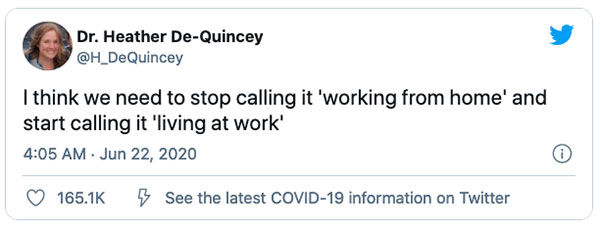The Fourth Industrial Revolution brings an incredible wave of new innovations from artificial intelligence to robotics. With technology changing so rapidly, companies need to look beyond traditional, one-size-fits-all education platforms and seek out new approaches to learning. In fact, workplace learning is a proven driver of success — employees who spend more than five hours a week learning are 39% more productive, 47% less stressed and 21% happier on the job…
— from the SalesForce.com website, March 2019
According to news reports, it sounds like the COVID pandemic has become rather serious in India over the past month or so.
I suppose it’s a natural thing, for Americans like myself, to think of “remote work” as an essentially “American” phenomenon — as something that has become more popular. and more necessary, here in the land of 600,000 COVID deaths. (The US has seen twice as many confirmed COVID fatalities as India, thus far.)
We don’t often consider, perhaps, that “remote work” has exploded in many other places around the globe. And that other people, in other lands, are also trying to figure out how to make this whole thing blend.
Some tips, from “14 Work From Home Tips To Maximize Your Productivity” written by Dipshi Bhattacharjee on the VantageCircle.com website, May 17, 2021:
1. Get dressed. Don’t work in your pajamas.
2. Set up a dedicated work area, with a comfortable chair you can bear to sit in for 8 hours.
3. Invest in the best possible technology — computer, monitors, software, peripherals. Whatever your budget will allow.
4. Schedule regular work hours.
5. Eat healthy food; get enough sleep.
6. Leave time for yoga and meditation; take a daily walk.
That’s part of the list.
Here’s Number 14:
14. Create a Stress-free Zone
What does it feel like to work from home? As you know it, working in an office can get pretty wearing. But it would be wrong to assume that working at home is not, for it is not a cakewalk either.
It takes serious concentration to work a full-time job from an unconventional space. Your attention can drift… all the time. You might start having some irrelevant thoughts, out of the blue. However, this is not something to worry about. Cut yourself some slack. It is absolutely okay to take your mind off work for a few minutes, intentionally or not.
You need not beat yourself up for that…
Balance your efficiency with self-care; if you are not mentally well, you cannot give your best…
Experiments with remote work have been going on for the past 20 years.
In 2005, Best Buy announced its innovative “Results Only Work Environment” which allowed employees the flexibility to work either from home or in the office — the employee’s choice. The program drew praise from flexible-schedule advocates, and won the company a cover story in BusinessWeek.
Best Buy canceled the program in 2013 following a series of “less profitable” years, and the company has since greatly improved its bottom line.
Was remote work a bad decision? For Best Buy, it might have been. Or maybe just “too much, too soon”?
Perhaps the most unsettling experience of ‘remote work’ resulted from the closure of public schools all around the world, starting in March 2020. Here in Pagosa Springs, and in much of America, the typical model of education has depended on a dominant adult — the classroom teacher — directing a room of maybe 30 students through various activities. “Classroom management” has played a significant role in this educational model. Keeping students ‘on task’ required a range of psychological tools, and a knack for maintaining focus throughout most of a 6-7 hour school day.
Suddenly, in March 2020, students and teachers were thrown into a very different world, dependent upon “remote learning”. Computer platforms such as Zoom and GoToMeeting were called into service, to try and replace the teacher-directed classroom experience, and parents — now suddenly charged with child care duties at home — quit their jobs or switched to remote work. Challenges quickly made themselves evident. Teachers, students and the parents often found ‘Zoom learning’ to be an experience of essential dreariness. Many families had to scramble to find internet service during class session, and some found themselves sitting in cars outside of a public library (which was closed due to COVID) using a public internet connection.
Parents were often juggling “remote work” with “remote school”. Not an ideal situation, I would imagine.
From what I can tell, most US schools have re-opened their doors by now, but some districts still continue to operate at least partially via Zoom, even a year into the pandemic.
We started today’s installment with a quote from the SalesForce.com website, talking about the “Fourth Industrial Revolution.”
The Fourth Industrial Revolution is a way of describing the blurring of boundaries between the physical, digital, and biological worlds. It’s a fusion of advances in artificial intelligence (AI), robotics, the Internet of Things (IoT), 3D printing, genetic engineering, quantum computing, and other technologies. It’s the collective force behind many products and services that are fast becoming indispensable to modern life. Think GPS systems that suggest the fastest route to a destination, voice-activated virtual assistants such as Apple’s Siri, personalized Netflix recommendations, and Facebook’s ability to recognize your face and tag you in a friend’s photo.
As a result of this perfect storm of technologies, the Fourth Industrial Revolution is paving the way for transformative changes in the way we live and radically disrupting almost every business sector. It’s all happening at an unprecedented, whirlwind pace…
Each of the previous “industrial revolutions” changed the way particular segments of the population lived and worked — and eventually, how everyone lived and worked. Some of the changes were ultimately pleasant enough; some were not.
But we’re an adaptable species. Maybe we can learn how to get through this current transition?


